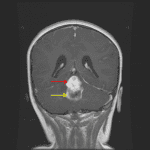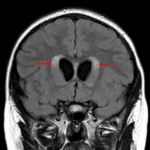Age: 5
Sex: Female
Indication: Headache, somnolence
Save ("V")
Case #1
Findings for this case
CT
- Hypoattenuating mass centered in the fourth ventricle with a more solid appearing component superiorly
- Associated obstructive hydrocephalus and periventricular edema
MRI
- Mixed solid and cystic mass centered in the fourth ventricle measuring 2.5 x 2.5 x 4 cm with a more solid enhancing component superiorly and a peripherally-enhancing cystic component inferiorly
- No corresponding restricted diffusion
- Associated effacement of the fourth ventricle and obstructive hydrocephalus with periventricular edema
Diagnosis & Discussion
Pilocytic astrocytoma
Background
- Think about JPA when you encounter a “cyst with nodule” mass, or any enhancing mass for that matter, in the posterior fossa in a child
- There is a strong association between optic pathway gliomas and NF1
Imaging Findings
- The “cyst with nodule” appearance is classic, but a minority of tumors do not demonstrate cystic components
- The solid component is usually hypoattenuating to brain on CT, T2 hyperintense, solidly enhancing, and does not demonstrate restricted diffusion
- Internal hemorrhage is rare
- Calcification is not usually seen
Differential
- Ependymoma – Avidly enhancing tumors with a predilection for the fourth ventricle in children, these tend to be more malleable (including the characteristic appearance of tumor bulging through the foramina of Luschka) and are less likely to have cystic components
- Medulloblastoma – Avidly enhancing, commonly midline posterior fossa tumors, these tend to present at a younger age (3-9 years old) and classically have associated restricted diffusion
- Hemangioblastoma – Also “cyst with nodule” tumors, these are more common in adults and in patients with von Hippel Lindau disease
- High-grade glioma – These tend to occur in older children and are often more heterogeneous and poorly marginated than JPAs. Also, unlike JPAs, these have a propensity for CSF dissemination
Pearls
- Think about JPA when you encounter a “cyst with nodule” mass, or any enhancing mass for that matter, in the posterior fossa in a child
- There is a strong association between optic pathway gliomas and NF1




 View shortcuts
View shortcuts Zoom/Pan
Zoom/Pan Full screen
Full screen Window/Level
Window/Level Expand/collapse
Expand/collapse Scroll
Scroll Save the case
Save the case Close case/tab
Close case/tab





 Previous series (if multiple)
Previous series (if multiple) Next series (if multiple)
Next series (if multiple)
